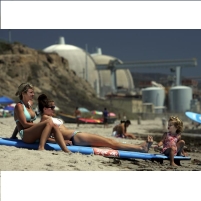Damage at California Nuclear Power Plant Worse than Earlier Reported
Saturday, July 14, 2012
 San Onofre Nuclear Power Generating Station (photo: Orange County Register)
San Onofre Nuclear Power Generating Station (photo: Orange County Register)
Even if you listened closely you wouldn’t have heard the sound of decaying tubes carrying radioactive steam through the now-shuttered San Onofre Nuclear Generating Station between San Diego and Los Angeles.
And you would have to look very closely now to see data—buried on the U.S. Nuclear Regulatory Commission (NRC) website—detailing just how bad that decay is. “The problem is vastly larger than has been disclosed to date,” according to Daniel Hirsch, a lecturer on nuclear policy at the University of California, Santa Cruz.
That data, posted here and here, details how the critical tubes that work to cool off the reactors have decayed at an astonishing rate. A report last month attributed the deterioration to a faulty computer program that predicted how much friction and vibration the tubes would be subjected to.
The alloy tubes, which are expected to show a certain amount of regular wear, were put in place by Southern California Edison in 2010 and 2011 when it installed four new steam generators at a cost of $671 million. The upgrade was paid for with Edison and San Diego Gas & Electric customer rate increases, but was expected to save $1 billion over the next decade.
San Onofre’s two nuclear units have been shut down since January when leaks of radioactive steam were detected.
The NRC records show investigators found wear from friction and vibration in 15,000 places, in varying degrees, in 3,401 tubes inside the generators. The four generators each have nearly 10,000 alloy tubes. Southern California Edison previously said that it would take 1,300 tubes out of service, a number well within the margin to keep the generators operating. Tubes are retired if more than a third of the tube wall erodes.
A report by Fairewinds Associates used the NRC data to determine that San Onofre has had to plug 3.7 times as many bad tubes as all other nuclear plants in the country combined. While regulators wrestle with when, or if, the nuclear plant can be reopened, Fairewinds said operating the reactors with the remaining, worn tubes could create cascading failures, leading to a catastrophic failure that would release significant radiation.
–Ken Broder
To Learn More:
Report Details on Tube Wear at Nuclear Plant (by Michael R. Blood, Associated Press)
Special NRC Oversight at San Onofre Nuclear Generating Station: Steam Generator Tube Degradation (U.S. Nuclear Regulatory Commission)
Federal Report Says San Onofre Nuke Plant Might Need to Replace Steam Generators (by Ed Joyce, KPCC)
San Onofre’s Steam Generators: Significantly Worse than All Others Nationwide (by Arnie Gundersen, Fairewinds Associates) (pdf)
Root Cause Evaluation: Unit 3 Steam Generator Tube Leak (Southern California Edison) (pdf)
- Top Stories
- Unusual News
- Where is the Money Going?
- Controversies
- U.S. and the World
- Appointments and Resignations
- Latest News
- Trump to Stop Deportations If…
- Trump Denounces World Series
- What If China Invaded the United States?
- Donald Trump Has a Mental Health Problem and It Has a Name
- Trump Goes on Renaming Frenzy






Comments